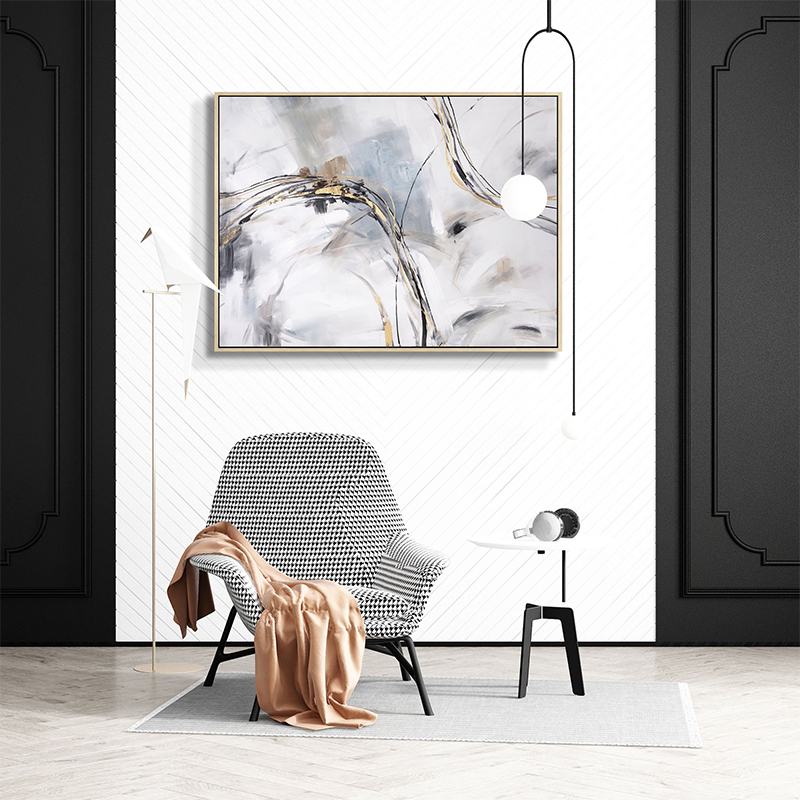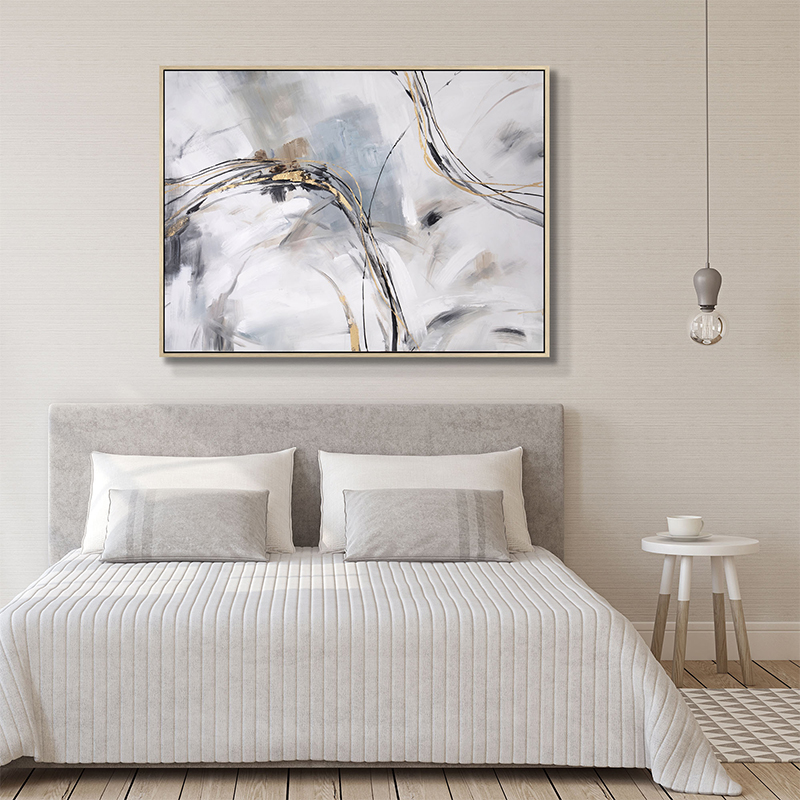In the diverse expressions of contemporary visual art, swirling lines art with floater frame stands out with its unique formal language. It does not rely on figurative imagery or complex colors, but instead constructs the picture with pure, continuous, and rotating curves, containing surging energy and profound emotion within a seemingly minimalist structure. The reason this art form can evoke strong psychological resonance in viewers lies in its masterful use of "flowing curves"—these curves are not only guides for visual pathways but also weavers of emotional rhythm. This article will analyze, from the perspectives of visual psychology, compositional principles, dynamic perception mechanisms, and emotional symbolism, how swirling lines art with floater frame uses flowing curves to create intense visual dynamics and emotional tension.
I. The Innate Affinity for Curves: Triggering Instinctive Visual Pleasure
The human preference for curves has a biological basis. Research shows that, compared to sharp straight lines or angles, the brain processes smooth curves more easily, and the amygdala exhibits significantly lower activity when encountering curves. Swirling lines art with floater frame builds upon this "curve affinity." Its lines meander and flow without a clear beginning or end, forming a coherent and soothing visual flow that immediately induces a sense of relaxation and pleasure in the viewer. However, this "softness" is not static gentleness but a flexible quality imbued with latent energy—much like flowing water, wind traces, or nebula trails, where power lies beneath a calm surface. This paradoxical unity sets the stage for subsequent emotional tension.
II. The Vortex Structure: The Core Engine of Visual Gravitation
The vortex is one of the most dynamic forms in nature—from the eye of a hurricane to the spiral arms of a galaxy, from the growth patterns of shells to water whirlpools, it symbolizes the convergence, transformation, and release of energy. In artistic creation, the vortex structure inherently possesses strong visual guiding power. When artists spiral multiple flowing curves around one or more central points, the picture forms a distinct "visual gravitational field." The viewer's gaze is inevitably drawn into the vortex center and cycles along the curved paths, creating an immersive viewing experience. This sensation of "being pulled in" not only enhances the pictorial depth but also produces an illusion of prolonged time—as if the moment of gaze is stretched, and reality and illusion merge here. It is this continuous visual movement that constitutes the most fundamental source of "dynamism" in swirling lines art with floater frame.
III. Rhythm and Cadence: The Visual Encoding of Emotional Undulation
Flowing curves are not uniformly repetitive but filled with rhythmic variation. By controlling the thickness, density, curvature, and turning speed of the lines, artists impart a musical cadence to the picture. For instance, densely packed vortex areas convey tension, urgency, or anxiety, while expansive arcs evoke tranquility, freedom, or sublimity. When vortices of different rhythms are juxtaposed or nested, the picture creates contrasts and dialogues of emotion—akin to the alternation of forte and piano, fast and slow in a symphony. As viewers' eyes wander through the composition, they unconsciously "synchronize" with this rhythm, their heartbeats and breathing rising and falling accordingly, thereby achieving deep emotional resonance. This ability to translate abstract emotions into readable visual rhythms is the core mechanism of emotional tension in swirling lines art with floater frame.
IV. Infinite Loops and a Sense of Incompleteness: Evoking Psychological Projection
Swirling lines often lack a clear start and end point, presenting a "infinite loop" topological structure. This openness breaks the boundary sense of traditional painting, suggesting continuation beyond the frame and stimulating the viewer's imagination to fill in the blanks. Simultaneously, the "unfinished" quality of the flowing curves—as if still growing, rotating, or spreading the next second—endows the work with a dynamic "present continuous" attribute. This uncertainty becomes an ideal vessel for emotional projection: the anxious might see a vortex spiraling out of control, while the meditative perceive the breath of the cosmos. Art ceases to be merely an object of viewing and becomes a mirror of the viewer's inner world. It is this participatory interpretation that extends emotional tension from within the picture to the depths of the viewer's psyche.
V. Synergistic Reinforcement through Color and Texture: Multi-Sensory Emotional Resonance
Although lines form the skeleton of vortex art, the choice of color and texture greatly enhances its emotional expressiveness. Cool-toned vortices often create a profound, mysterious, or even melancholic atmosphere; warm colors convey passion, energy, or sanctity. The use of gradient colors can simulate the refraction and flow of light within the vortex, enhancing the three-dimensional illusion. Furthermore, contemporary artists often incorporate metallic foil, fluorescent pigments, relief textures, or even digital dynamic projections to create illusions of shimmering, undulation, or slow rotation in static images. This multi-sensory stimulation amplifies visual dynamics and extends emotional tension from the visual dimension to tactile and temporal perception.
VI. Cultural and Psychological Symbolism: Awakening the Collective Unconscious
As an archetypal image, the vortex is deeply rooted in the human collective unconscious. In Jungian psychology, the vortex symbolizes self-integration in the individuation process, the surge of the subconscious, or the critical point of spiritual crisis. In Eastern philosophy, the rotating yin-yang fish of the Taiji symbol is the most classic vortex metaphor, representing the eternal law of unity in opposition within the cosmos. When viewers engage with swirling lines art with floater frame, these deep cultural memories are quietly activated, endowing the work with symbolic meaning beyond form. Therefore, its emotional tension arises not only from visual stimulation but also from metaphorical responses to the essence of life, the passage of time, or existential dilemmas.
The allure of swirling lines art with floater frame lies in its use of the simplest visual element—flowing curves—to construct the most complex emotional field. Without narrative, it tells of cosmic rhythms; without figures, it reflects inner storms. Through the gravitational pull of the vortex structure, the orchestration of rhythmic cadence, the openness of infinite loops, and the synergy of color and texture, it successfully transforms "dynamism" into palpable emotional energy.



